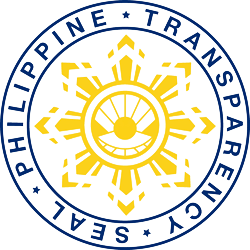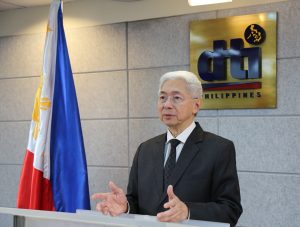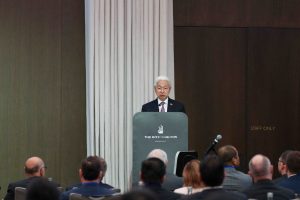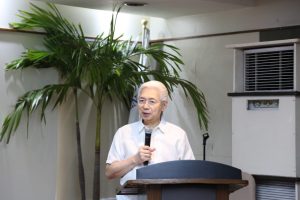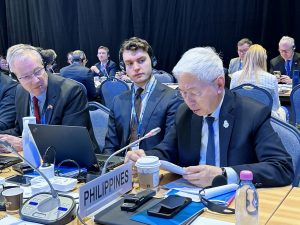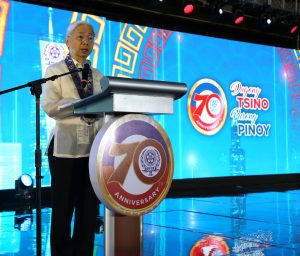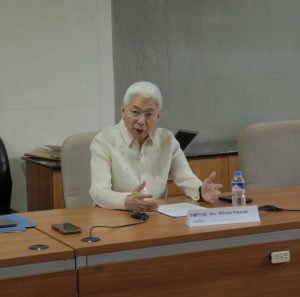3 March 2021 via Facebook live
Ladies and gentlemen, good afternoon.
We would like to offer our warm greetings to the guests and participants of today’s forum. We hope that everyone is keeping safe against the COVID-19 pandemic.
Let me thank also the organizers, the Association for Philippines-China Understanding (APCU) and the Embassy of the People’s Republic of China to the Philippines, for the privilege of addressing your audience.
Before anything else, I would like to recognize the presence of my former boss and mentor when we were both younger, in the earlier years of our career as technocrats at the Department of Trade and Industry in the 80’s, before she entered politics and before I joined the business sector. She is an esteemed economist and was top notch Senator before becoming the Philippine President, Madam Gloria Macapagal-Arroyo. I learned that she was also one of the founders of APCU and now serves as its chairperson emeritus. (Let’s give a big hand for the former PGMA).
As of present, the APCU is the leading institution in the country promoting people-to-people diplomacy between the Philippines and China.
Last year, our two nations marked the 45th anniversary of diplomatic relations. However, the roots of our trade and cultural bonds span longer than that, with Chinese merchants trading with their Filipino counterparts even before the Spanish arrived on our shores in the 16th century. And as our two countries deepened bilateral ties throughout the years, we saw this relationship grow and thrive during the time of then-President Macapagal-Arroyo.
It was during the term of Philippine President Rodrigo Roa Duterte and his independent foreign policy in 2016 that this relationship began to flourish again, like a profusion of flowers blossoming in the spring of renewed friendship, coming out after a cold winter.
This strong bond of friendship was once again witnessed last Sunday with the arrival of the first batch of Sinovac COVID-19 vaccine donated by China. This donation—which the Chinese Ambassador to the Philippines Huang Xilian worked hard for, and backed up by no less than Chinese President Xi Jinping—has brought much hope to the Filipino people. The arrival of the vaccine, and the immediate rollout of the vaccination program the following day certainly brought about heightened optimism in seeing the beginning of the end of COVID-19 pandemic. This definitely lifted the spirits of many Filipinos, and will surely lead to greater business and consumer confidence on the road to recovery.
I earlier mentioned that Philippine-China ties date back centuries ago and is deeply-rooted socially, culturally, and commercially. Chinese and Filipino-Chinese businesses have long been part of our society and economy. Many of the biggest conglomerates in almost all industries and their founders—who we refer to as Taipans—trace their roots from China.
More recent investments from China in the Philippines that we can cite include DITO Telecommunity, which is the country’s incoming major telecom operator. There is also the APF Group Holding Corp., producer of slabs and hot rolled coils in Misamis Oriental, and Florida Blanca Steel Industries, an export producer of steel pipes in Pampanga. Meanwhile, there is the Liangan Power Corp., a renewable energy developer in Lanao del Norte, while Hydrocore is developing the Ibulao Hydroelectric Project in the Ifugao Province.
We’d also like to cite the millions of Filipino-Chinese businesses in manufacturing and retail in the country, as well as several Filipino-Chinese communities in the Philippines with strong ties to their Filipino neighbors.
In terms of trade, China is our country’s top trading partner, our 3rd largest export market, and our foremost import supplier. What’s more, China is our 2nd top investment partner for 2019, with the same ranking as of January to September 2020.
The Chinese Ministry of Commerce (MOFCOM) also reported that during the last three years, project contracts signed by Chinese enterprises in the Philippines increased 27.9% annually, with turnover increasing by 18.5% annually. In 2019, newly-signed contracts were worth USD 6.4B with a growth of 102%. In 2020, newly signed contracts reached USD 9.59B, up 54% year-on-year.
But even with all these business deals, there are still a wide range of investment opportunities available in our country that investors can take advantage of presently. These include: manufacturing of e-vehicles, e-bikes, and bicycles; light industries manufacturing for connectivity devices, bags, and textile manufacturing; and Internet of Things (IoT), Smart Manufacturing, and AI; among so many others.
The Philippines has also been actively participating in China’s major platforms to promote trade and investments, like the China International Import Expo (CIIE), the China-ASEAN Expo (CAExpo), and the China International Fair for Trade in Services (CIFTIS). In addition, we are the Guest Country of Honor at the China International Fair for Investments and Trade (CIFIT) for two years. Furthermore, our country has been taking an active role in the Belt & Road Initiative of President Xi Jinping.
Even with the pandemic, we’re looking forward to the convening of the 29th Philippines-China Joint Commission on Economic and Technical Cooperation (JCETC) at the soonest possible time this year through videoconference. Plus, we have four Philippine Trade and Investment Centers (PTIC) in China—Beijing, Shanghai, Guangzhou, and Hong Kong—that can engage with Chinese enterprises pursuing “going-out” strategies.
As the world deals with the COVID-19 pandemic, we wish to congratulate China on your economy’s recovery thanks to your quick response to the outbreak. Here in the Philippines, we’re already seeing signs of economic recovery as we push for the gradual and calibrated reopening of our economy. Despite our GDP falling to -9.5% in 2020, we saw diminishing declines in the latter quarters of last year: from a record-low -16.5% in the 2nd quarter to -11.5% in the 3rd quarter and -8.3% in the 4th quarter. Growth is seen quarter-on-quarter as our GDP grew by 8% from 2nd to 3rd quarter, and 5.6% from 3rd to 4th quarter.
Investments registered in our Board of Investments showed sustained growth of 156.02% YOY in the first 2 months of this year, reaching P121.93B or USD 2.5B for 2 months.
The barometer for manufacturing activities, the Philippine Manufacturing Purchasing Managers’ Index (PMI), likewise, showed a steady rebound in January showing a 52.5 index, and remained unchanged in February. Any number above the 50 marks growth in the sector. This came from a huge decline at 31.6 last April 2020 at the height of the lock down.
As our economy recovers, we are confident of achieving our pre-pandemic growth rates and beyond. To this end, we are facilitating greater trade and investment in the country by continuously pursuing reforms to foster a better business environment. That’s why we have the game-changing Corporate Recovery and Tax Incentives for Enterprises Act or CREATE awaiting the signature of President Duterte.
Making the investment climate in the Philippines significantly more attractive, the CREATE bill will rationalize, modernize, and offer more relevant incentives to investors. Under the ratified version of the bill, qualified activities or projects can enjoy the incentives package for a maximum of 17 years. These include four to seven years of Income Tax Holiday (ITH), and a 5% Special corporate income tax (CIT) rate based on Gross Income Earned (GIE) for 10 years, in lieu of all national and local taxes, among others.
Other key features of the bill that can be enjoyed by investors include the removal of export and nationality bias, and the reduction of CIT rate from 30% to 25% for domestic corporations, foreign corporations, and non-resident foreign corporations. There is also the President’s flexibility in granting incentives for highly desirable projects with minimum investment capital of P50B or at least 10,000 job generation, but noting that total period of availment will not exceed 40 years.
We also remain committed in supporting liberalization to enhance our country’s competitiveness. This means amending laws like the Retail Trade Liberalization Act (RTLA), the Foreign Investments Act (FIA), and the Public Services Act (PSA). Together with CREATE, these reforms—and the review of other economic restrictions being conducted by members of Congress with the intention of removing barriers for entry—will attract more investments and create more jobs in the Philippines.
Lastly, as members of the Regional Comprehensive Economic Partnership or RCEP, China can strategically partner with the Philippines as we have a complimetary comparative advantage to become a hub for innovation, R&D, and manufacturing, particularly in design and creativity-oriented products and services, in the region. The Philippines can also become a center for education and training. Once the agreement becomes effective, RCEP is expected to boost intra-regional investment and trade with ASEAN expected to play a vital role in this agreement.
As the Chinese saying goes, “Fate brings people together from far apart.” Our two nations continue to enjoy stronger trade and investment ties. Thus, we hope that you will partner with us to build back better towards a better and brighter post-COVID future. And through the jobs and employment generated by the business and investments you bring in, the Filipino people will also gain a more comfortable and higher quality of life as promised by our President Rodrigo Roa Duterte.
Thank you, xie xie, and mabuhay po tayong lahat. ♦
Date of Release: 3 March 2021

